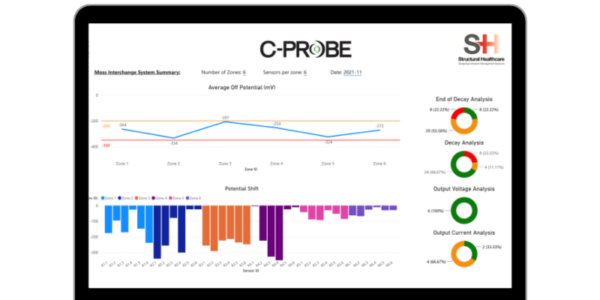A substantial proportion of our existing infrastructure is ageing and will be going through some form of deterioration – most notably corrosion. Understanding corrosion, and corrosion rates, is necessary to ensure that the design of infrastructure we utilise every day, from buildings, bridges, and marine ports, is safe and fulfills its performance specifications. Corrosion rate tracking is key to giving asset owners an insight and take control of their asset’s structural health, which the Achilles interactive Management Server (AiMS) does. AiMS is also the remote-control facility for operating and managing impressed current cathodic protection (ICCP) systems and collects corrosion rate data – we discuss the benefits of implementing a system such as this:
1. Prevent serious structural damage caused by corrosion
Corrosion causes significant structural damage to ageing buildings on a global scale – NACE International published in their IMPACT report that 70% of structural damage is caused by corrosion. It is moisture entering the structure that causes corrosion of the internal steel frame, which leads to the expansion of the steel to around seven to ten times the volume of the original metal. It can take a small amount of corrosion to create large tensile forces within the masonry, causing cracking and displacement of the cladding, impacting the safety and aesthetic of the any infrastructure.
Embeddable probes and a management system, like AiMS, offers a clear view of corrosion activity and the level of degradation in certain areas within the asset. Having access to tangible data can help to inform the next steps needed for maintenance and protecting your asset from further damage.
2. Make predictive maintenance decisions
Linking with the previous reason, having corrosion rate tracking implemented within your asset means owners can be proactive with their decisions. Instead of waiting for the damage to become worse and more expensive, you have the technology which has identified the problem area, therefore can reach an early solution before failure happens. From a financial perspective, this is a good cost saving tactic as you can pre-empt major repairs. Corrosion is a costly problem and is said to cost US$2.5 trillion, equivalent to 3.4 percent of the global Gross Domestic Product (GDP)[1].
3. Protect your investment and asset value
Corrosion rate tracking not only saves money in terms of repairs but protects the overall asset value. It is common for developers to invest in old structures, but aggressive environments and natural ageing causes deterioration, making it less valuable than new buildings. Taking advantage of sustainable, smart build materials and technology to prevent structural failure will help to protect the value and extend the service life for many additional years.
4. Demonstrate ESG
Responsible investing and the role of Environmental, Social and Governance (ESG) has become increasingly important in the last few years – demonstrating ESG has shown higher returns on investments, lower risks, and better resiliency during a crisis. Enabling corrosion rate tracking fulfils all the criteria of ESG:
Environmental – C-Probe Systems provides the low carbon anode mortar, LoCem®, which forms the corrosion protection component of the whole installed system. LoCem®’s most notable features are that it is made from recycled waste streams and low CO2 emissions in its ambient blending (90% less than CEM1). In addition to this, the idea of protecting and recycling an existing structure contributes to NetZero and cuts construction pollution, by reducing the rate we are constructing new infrastructure.
Social – Through corrosion rate tracking, owners are benefiting the surrounding community by keeping disruption at a minimum. For example, corrosion rate tracking of a bridge could be considered vital, as closing a bridge due to repair works would create huge disruption and prevent important services from being delivered.
Governance – The data that is communicated via AiMS fulfils these criteria, as the structural data ensures transparency. The implementation of the corrosion mitigation system means that there is remote control, data acquisition and prevention of future corrosion that meets international standards for protection of reinforced concrete and masonry structures, such as BS EN ISO12696:2022 and BS EN ISO15257:2017.
5. Contribute to a sustainable built environment
The climate emergency has forced the construction sector to re-evaluate their practices and explore more sustainable technologies and alternatives available. Corrosion rate tracking through a server facility like AiMS, offers more control over service life to asset owners. Combined with low carbon corrosion protection, repair and build materials, a future-proofed strategy can be formed to allow infrastructure to quickly bounce back from difficulties and means that they are constantly reused. This is instead of being teared down and starting again thereby preserving embodied carbon for the whole life of the structure.
New infrastructure is not the sustainable option and should only be done if absolutely necessary. For these new structures, rethinking the structural design and implementing technology that allows corrosion rate tracking means the asset’s maximum value is extracted, whole life performance is extended, and structural resilience is enhanced.
 The old Terry’s Chocolate factory in York (2015) was restored via C-Probe’s corrosion protection materials. To this day, the structure is controlled, and corrosion rate tracking is provided through AchillesICP and AiMS open network server.
The old Terry’s Chocolate factory in York (2015) was restored via C-Probe’s corrosion protection materials. To this day, the structure is controlled, and corrosion rate tracking is provided through AchillesICP and AiMS open network server.
—————————————————-
Ensure you visit C-Probe Systems at the Smart Asset and Estate Management Conference to find out more about their restoration services, corrosion rate tracking and AiMS management server. Visit them at www.c-probe.com or email cwalker@c-probe.com for more information.
[1] NACE, International Measures of Prevention, Application and Economics of Corrosion Technology (IMPACT) (2016), http://impact.nace.org/economic-impact.aspx

